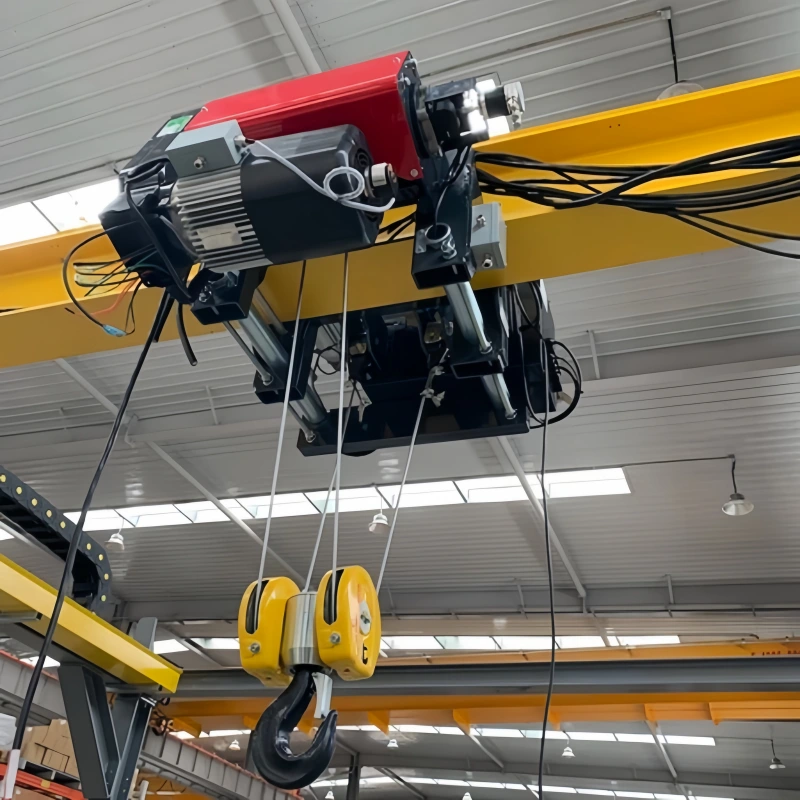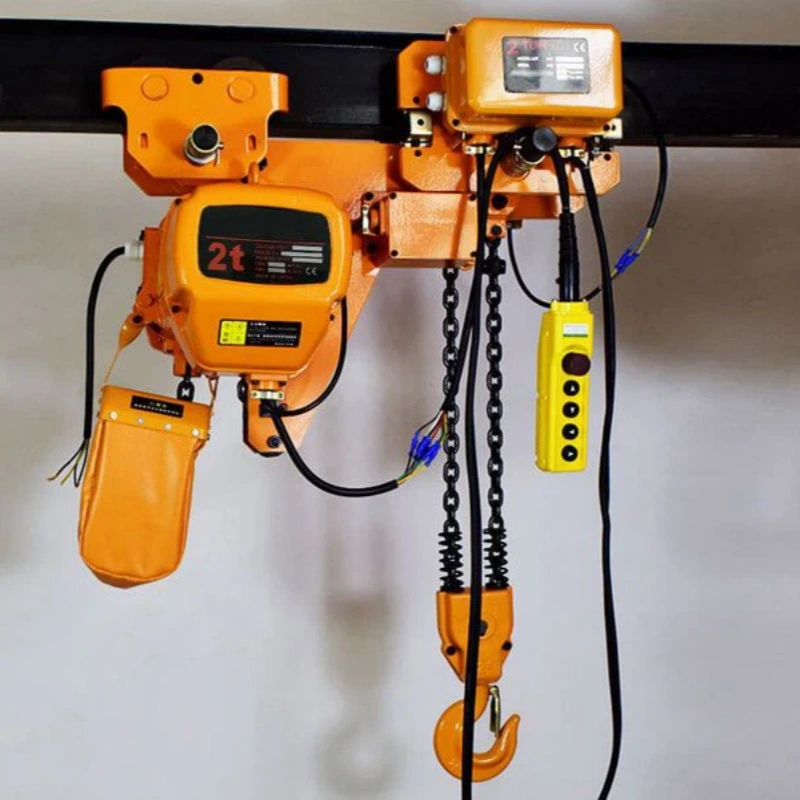The main difference between sling hooks and grab hooks lies in their function—sling hooks offer secure attachment for lifting slings, while grab hooks control chain length and prevent slipping. Selecting the right sling and rigging equipment impacts your safety and efficiency on every job.
Powerful Machinery delivers certified, high-performance solutions for both options, ensuring you meet the highest safety standards. As you face new demands in 2025, consider your industry’s unique requirements when evaluating sling hook vs grab hook for your lifting operations.
Key Takeaways
Sling hooks are designed for secure attachment of lifting slings, while grab hooks allow for precise control of chain length.
Choose sling hooks for heavy lifting tasks, as they often include safety latches to prevent accidental detachment.
Grab hooks excel in situations where you need to adjust chain length quickly, making them ideal for load binding and cargo control.
Always match your hook type to the correct chain grade to ensure safety and performance during lifting operations.
Regularly inspect your hooks for wear and damage to maintain safety standards and prevent accidents.
Sling Hook Overview
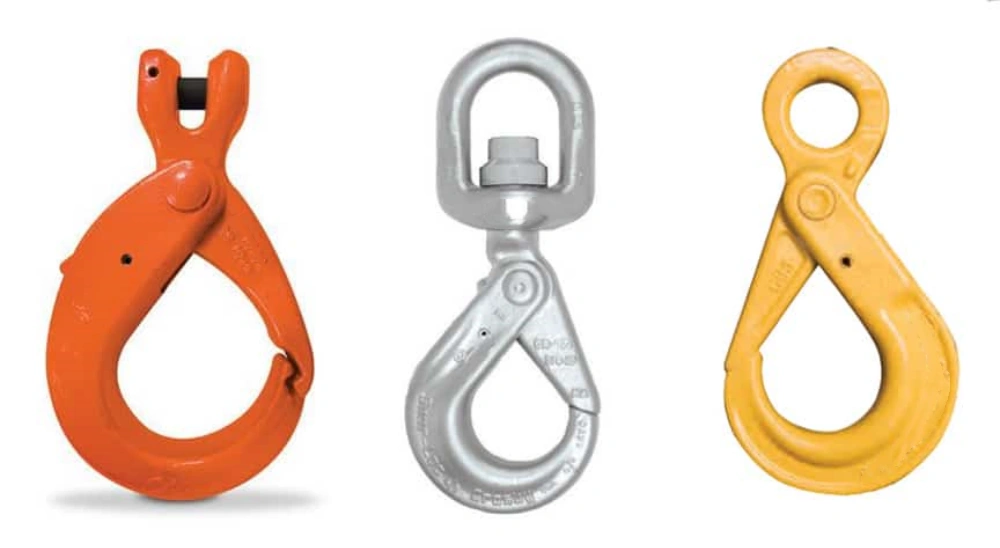
Design
You will notice that sling hooks feature a wide throat opening and a curved profile. This design allows you to attach lifting slings quickly and securely. Most industry standards require sling hooks to include a safety latch.
This latch prevents accidental detachment during lifting. The following table summarizes key requirements from leading safety standards:
Standard | Requirement |
|---|---|
OSHA 1910.181(j)(2)(ii) | Safety latch-type hooks shall be used wherever possible. |
ASME B30.2-2001 | Latch-equipped hooks shall be used unless impractical or unnecessary. |
Hooks designed to have a latch must have it installed.
Positive latching hooks are robust and engineered to prevent accidental opening.
Sorting hooks and foundry hooks typically do not use latches due to their specific applications.
You can rely on sling hooks for secure load engagement, especially when handling heavy or awkward items.
Powerful Machinery Features
Powerful Machinery sets itself apart by offering sling hooks that meet and exceed global safety standards. You benefit from rigorous testing procedures, which ensure every hook delivers consistent performance.
The patented self-locking hook design eliminates the need for extra safety latches, streamlining your workflow. Grade 100 chains provide an improved strength-to-weight ratio, so you can downsize your rigging without sacrificing lifting capacity. The table below highlights these unique features:
Feature | Description |
|---|---|
Rigorous Testing Procedures | Every chain undergoes stringent safety and durability tests, ensuring high quality and reliability. |
Patented Self-Locking Hook | A unique locking mechanism that enhances productivity by eliminating the need for extra safety latches. |
Improved Strength-to-Weight Ratio | Grade 100 chains allow for downsizing while maintaining lifting capacity, making them easier to handle. |
You gain peace of mind knowing that each sling hook from Powerful Machinery is engineered for demanding environments.
Applications
You will find sling hooks in a wide range of applications. Construction sites use them to lift beams, panels, and machinery. In marine operations, you rely on sling hooks for hoisting cargo and securing loads on deck. Manufacturing plants use these hooks for moving heavy equipment and materials.
Transportation and logistics companies depend on sling hooks to secure freight during transit. You can also use sling hooks in mining, where safe and efficient lifting is critical. These applications highlight the versatility and reliability of sling hooks in modern industry.
Grab Hook Overview
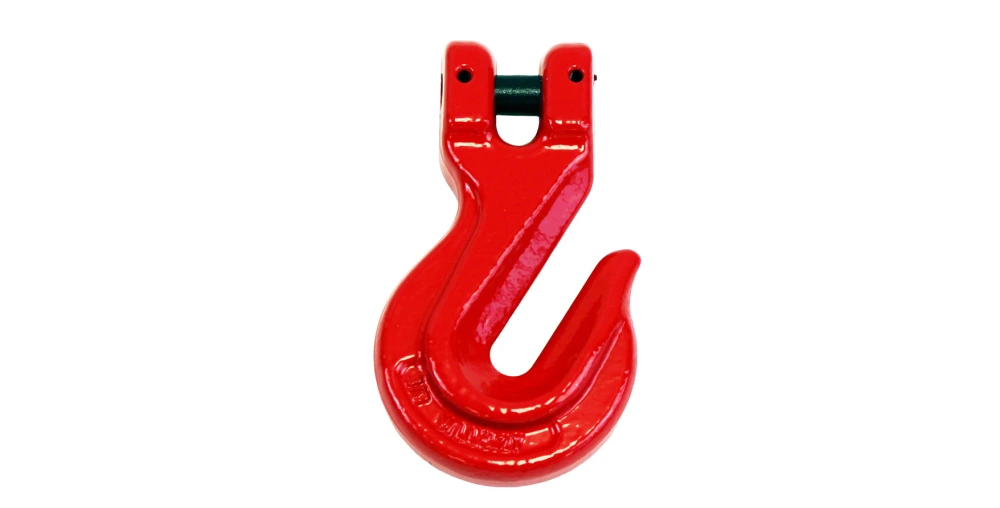
Design
You will notice that grab hooks feature a narrow throat and a robust, forged body. This design allows you to grip chain links securely without letting them slip through the hook. Grab hooks excel at shortening chains and controlling load length.
You can attach them directly to a specific link, which gives you precise control over tension and positioning. Unlike sling hooks, grab hooks do not include a safety latch. This difference makes grab hooks ideal for applications where you need to adjust chain length quickly.
Tip: Always check the compatibility between your grab hook and chain grade before starting any rigging operation.
Powerful Machinery Clevis Grab Hook
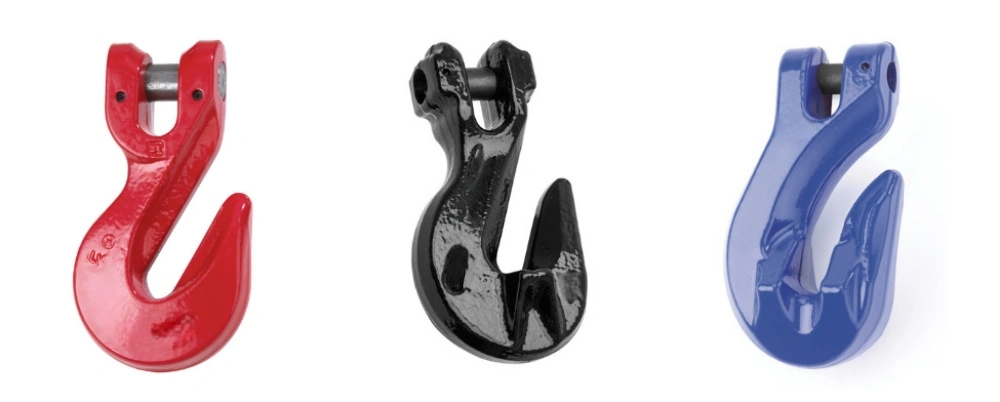
You gain several advantages when you choose the Clevis Grab Hook from Powerful Machinery. The hook features heat-treated alloy steel construction and a zinc finish, which provides excellent corrosion resistance. You benefit from a secure bolt and cotter pin system that prevents accidental detachment.
The wide throat opening and forged body ensure a strong grip on chain links, even in harsh environments. Powerful Machinery offers multiple sizes and working load limits, so you can select the right hook for your specific needs.
Feature | Benefit |
|---|---|
Heat-treated alloy steel | Enhanced durability and strength |
Zinc finish | Superior corrosion resistance |
Bolt and cotter pin | Secure attachment and safety |
Multiple sizes | Versatility for different applications |
Applications
You will find grab hooks in many industries, including construction, marine, and mining. These hooks work well for load binding, cargo control, and chain shortening tasks. You can use grab hooks to secure heavy equipment, stabilize loads on trailers, or adjust chain tension during lifting operations.
When you compare grab hooks to sling hooks, you see that grab hooks offer more control over chain length and load positioning. This feature makes them essential for professionals who need precision and reliability in demanding environments.
Sling Hook vs Grab Hook
Key Differences
When you compare the sling hook vs the grab hook, you see clear technical and functional differences. Sling hooks have a larger throat and often include a latch or self-locking mechanism.
This design lets you attach slings quickly and securely. Grab hooks, on the other hand, feature a narrow throat that grips a specific chain link. This gives you precise control over chain length and tension.
You can review the main distinctions in the table below:
Feature | Sling Hooks | Grab Hooks |
|---|---|---|
Throat Size | Larger throat | Narrow throat |
Latch Type | May include self-closing latches | Standard and cradle types |
Working Load Limit Reduction | Not required | 20% reduction for standard grab hooks |
Cradle Design | Not applicable | Cradle grab hooks do not require reduction |
Sling hooks from Powerful Machinery, such as those with patented self-locking designs, offer enhanced safety and efficiency. Grab hooks like the Clevis Grab Hook provide robust chain control, especially when you need to shorten or secure a load.
Load Handling
You handle loads differently depending on the lifting hook types you choose. Sling hooks excel at lifting heavy or awkward items because their wide opening and latch keep the load secure. You can use them for vertical, choker, or basket hitches, making them versatile for many lifting tasks.
Grab hooks give you more control over chain length. You attach the hook directly to a chain link, which lets you adjust tension or shorten the chain as needed. This feature is essential for load binding and cargo control.
However, you must remember that standard grab hooks require a 20% reduction in working load limit for safe operation. Always check the manufacturer’s guidelines before lifting.
Note: Cradle grab hooks from Powerful Machinery do not require this reduction, so you maintain full working load capacity. This advantage can improve your efficiency and safety during lifting.
When you compare sling hooks vs grab hooks in real-world lifting, you notice that sling hooks focus on secure attachment, while grab hooks prioritize chain adjustment and load control.
Compatibility
You must consider compatibility when selecting between a sling hook and a vs grab hook. Sling hooks work best with lifting slings, wire ropes, and high-grade chains. Powerful Machinery designs its sling hooks to fit Grade 80 and Grade 100 chains, ensuring you meet strict industry standards.
Grab hooks, such as the Clevis Grab Hook, are engineered for specific chain grades—most commonly Grade 43. Using the correct chain and hook combination is critical for safety and performance. If you use a grab hook with the wrong chain grade, you risk equipment failure or reduced load capacity.
Tip: Always match your hook type to your chain grade and lifting application. This step ensures you get the most from your equipment and maintain compliance with safety regulations.
When you evaluate types of lifting hooks, you see that sling hooks offer broad compatibility with various lifting setups, while grab hooks require careful matching to chain grade and application. Powerful Machinery’s certified product range covers both lifting hook types, so you can select the right tool for your job.
Pros and Cons
Sling Hook Advantages
You gain several important benefits when you use sling hooks for lifting. These hooks offer a wide throat opening, which makes it easy to attach slings and secure loads quickly. Most sling hooks include a safety latch or self-locking feature, so you reduce the risk of accidental detachment.
You can use sling hooks in many industries, from construction to marine, because they work well with different types of slings and chains. The robust design ensures reliable performance, even in tough environments.
You also benefit from compatibility with high-grade chains, which support safe and efficient lifting operations.
Sling Hook Disadvantages
You may notice some limitations with sling hooks. The larger throat opening, while helpful for quick attachment, can sometimes allow smaller items to slip if not properly secured. Sling hooks often require regular inspection to ensure the latch or locking mechanism works correctly.
In some cases, sling hooks may not provide the precise chain length adjustment you need for certain load control tasks. You must always match the hook size and type to your specific lifting application to avoid safety risks.
Grab Hook Advantages
Grab hooks deliver strong advantages, especially for load control and transport. You can see the main benefits in the table below:
Benefit | Description |
|---|---|
Quick Attachment | The clevis design lets you connect to chains fast and securely. |
High Strength | Made from high-strength steel, these hooks handle significant loads. |
Essential for Lifting | Offers a reliable connection point for heavy lifting applications. |
You also experience these practical benefits:
Enhanced safety by keeping cargo secure during transport.
Increased efficiency, as you can load and unload cargo faster.
Improved load stability, which helps heavy loads stay in place.
Grab hooks give you precise control over chain length, making them ideal for binding and securing loads. You can rely on their robust construction for demanding lifting and transport jobs.
Grab Hook Disadvantages
You should consider a few drawbacks when using grab hooks. The narrow throat design means you must match the hook to the correct chain size and grade. Grab hooks do not include a latch, so you need to check that the chain link stays properly seated during use.
Standard grab hooks may require a reduction in working load limit, which can affect your lifting capacity. Always follow manufacturer guidelines to ensure safe operation.
Choosing the Right Hook
Factors
Selecting the right hook for your lifting operation requires careful evaluation of several factors. You must consider the total weight of the load, the type of material, and the sling you plan to use. The method of hitching and the number of lifting points also play a critical role.
Environmental conditions, such as temperature and exposure to moisture, can affect hook performance. For example, extreme cold may cause brittleness, while high heat can reduce strength. Corrosion in marine or humid environments can lead to fatigue cracks.
Here is a table to help you assess the main factors:
Factor | Description |
|---|---|
Total weight of the load | The overall weight that will be lifted, which affects the choice of hook. |
Type of load or material | The nature of the load being lifted influencing hook selection. |
Type of sling being used | The specific sling type that will connect to the hook. |
Type of sling hitch | The hitch method used with the sling can affect stability. |
Connection to the load | Whether using shackles or engineered lifting points on the load. |
Number of lifting points | The quantity of points from which the load will be lifted. |
Overall distance between points | The distance between lifting points can impact the lifting angle. |
Sling angle | The angle at which the sling will be used affects load distribution. |
You should always match the hook to the chain grade and ensure compatibility with your specific applications. Powerful Machinery offers hooks certified under ISO9001, TUV Rheinland, and OSHA standards. These certifications guarantee that you receive products built for safety and reliability in demanding environments.
Mistakes to Avoid
You can avoid many common mistakes by following industry best practices. Here are some frequent errors and how to prevent them:
Using the wrong lifting gear for the job. Always assess the load type and environment before selecting your equipment.
Ignoring load capacity limits. Never exceed the Safe Working Load (SWL) of any hook or sling.
Inadequate load securing. Make sure you secure loads properly to prevent instability during lifting.
Neglecting environmental conditions. Consider temperature and corrosion resistance when choosing hooks for outdoor or marine use.
Using untested and uncertified lifting gear. Only select hooks with proper certifications to comply with safety regulations.
Tip: Always inspect your hooks and slings before use. Look for signs of wear, damage, or corrosion. Store your equipment in a cool, dry place to extend its service life.
By considering these factors and avoiding common mistakes, you ensure safe and efficient lifting operations. Powerful Machinery’s certified product range supports you in meeting the highest safety standards for every project.
2025 Expert Recommendations
Trends
You will see several important trends shaping the hook market in 2025. Manufacturers now focus on creating products that offer more than just basic function. You can expect to find hooks that combine strength with smart features and eco-friendly materials.
These trends reflect the changing needs of modern industries and consumers:
Multifunctional hooks now account for over 35% of product demand. You benefit from designs that handle multiple tasks, saving time and space.
Decorative and wall-mounted hooks have grown in popularity by 28%. You can improve both safety and workplace aesthetics.
Online sales have increased by 45%. You have easier access to certified products and detailed technical information.
Compact, space-saving hooks represent 33% of new launches. You can optimize storage and organization in tight workspaces.
Eco-friendly materials and finishes are becoming standard. You help reduce environmental impact while maintaining performance.
Tip: When you select hooks, consider both function and design. Modern hooks can improve efficiency and support sustainability goals.
Safety Tips
You must stay updated on new safety standards and inspection routines to protect your team and equipment. In 2025, industry authorities introduced updated regulations for hooks and lifting devices. The table below highlights key changes:
Standard | Description |
|---|---|
ASME B30.20-2025 | New requirements for adjustable and modular spreader bars, updated load test methods, and clearer guidelines for lifting devices. |
ASME B30.21-2025 | Revised standards for lever hoists, based on expert recommendations to improve safety. |
You should also follow recommended inspection intervals to ensure safe operation:
Service Level | Frequent Inspection Interval | Periodic Inspection Interval |
|---|---|---|
Normal Service | Monthly | Yearly |
Heavy Service | Weekly to Monthly | Semi-annually |
Severe Service | Daily to Weekly | Quarterly |
Always inspect hooks for wear, cracks, or deformation before use.
Replace any hook that shows signs of damage or fails inspection.
Store hooks in a dry, organized area to prevent corrosion.
Note: Adhering to updated standards and inspection schedules helps you maintain a safe and efficient workplace.
Conclusion
You now understand the essential differences between sling hooks and grab hooks. Matching the correct hook type to your application improves safety and efficiency.
Using the right hook prevents accidents and supports zero-harm initiatives.
Selecting the wrong hook increases risk and frustration.
Powerful Machinery stands out for rigorous quality control, comprehensive testing, and international certifications.
Requirement | Description |
|---|---|
Rated Load | Devices display clear rated load markings. |
Inspections | Regular checks ensure ongoing safety. |
Consult experts and review certifications to build a safe lifting program for every project.
FAQ
What is the main difference between a sling hook and a grab hook?
You use a sling hook to attach slings for lifting loads securely. A grab hook lets you shorten or adjust chain length by grabbing a specific link. Each serves a unique purpose in rigging and lifting.
Can I use a grab hook with any chain grade?
You should only use grab hooks with the chain grade specified by the manufacturer. For example, Powerful Machinery’s Clevis Grab Hook works best with Grade 43 chains. Using the wrong grade can reduce safety and performance.
How do I know which hook to choose for my application?
You need to consider your load type, lifting method, and environment. Always check the working load limit and compatibility with your chain or sling. Certified products from Powerful Machinery help you meet safety standards.
Do sling hooks always require a safety latch?
Most sling hooks include a safety latch or self-locking feature. This latch prevents accidental detachment during lifting. Some specialized hooks, like foundry or sorting hooks, may not require a latch.

